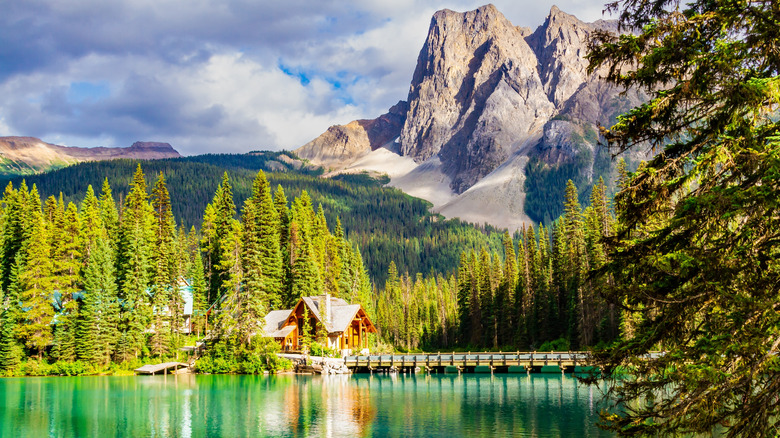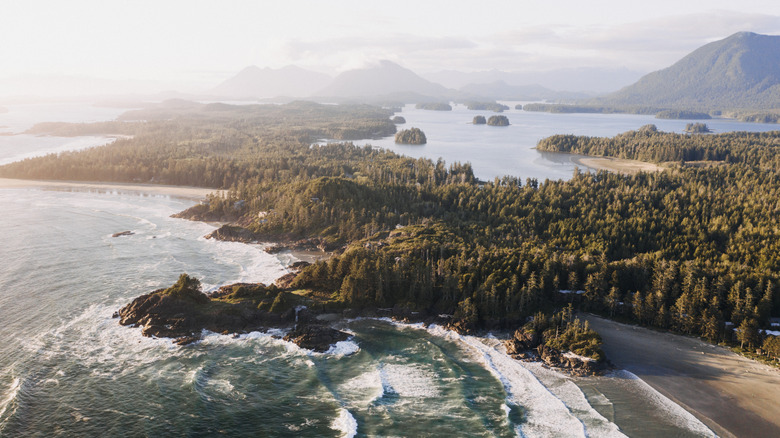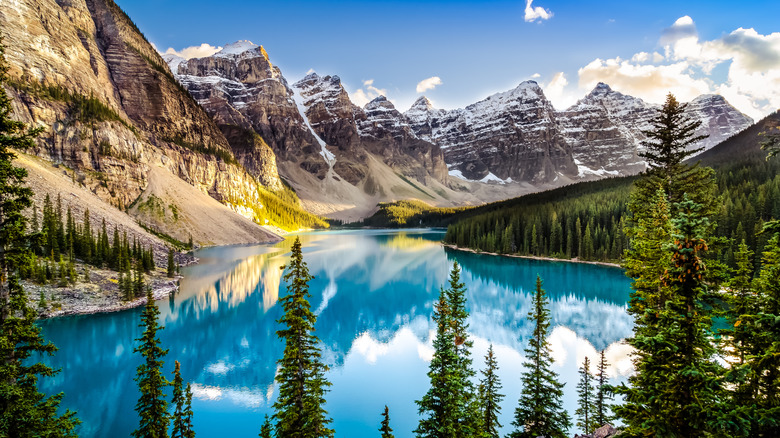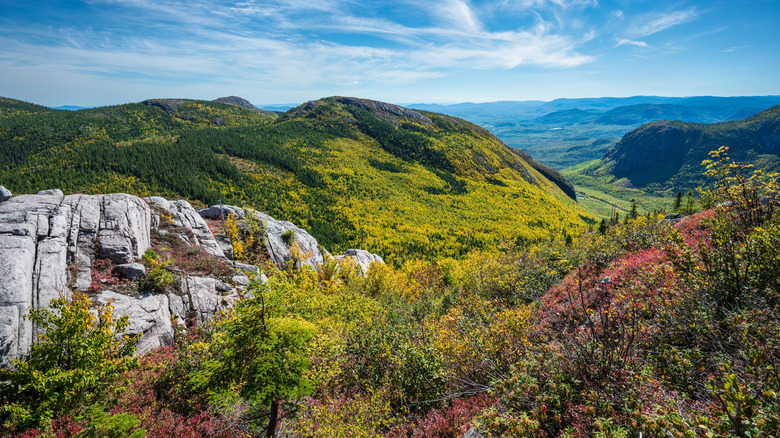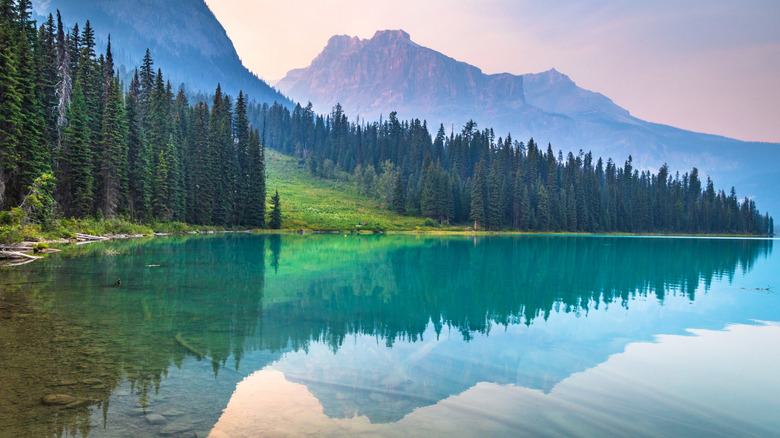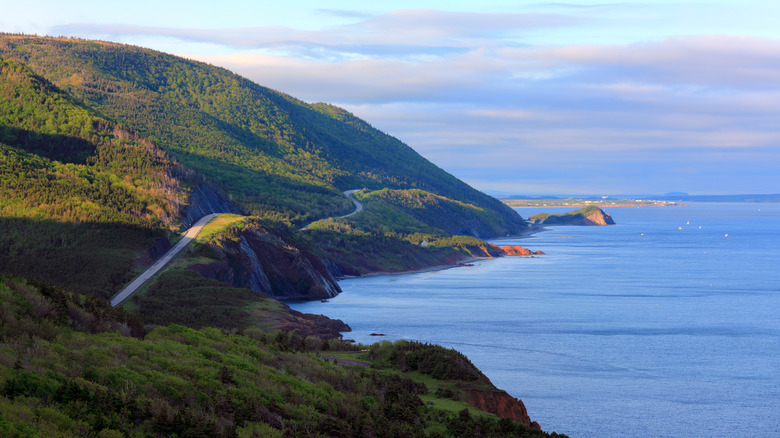To Avoid America's Overcrowded And Understaffed National Parks In 2025, Visit These Canadian Alternatives
In 2024, a record almost 332 million visitors ventured into U.S. national parks. Travelers from all over the world roved the wildflower trails of Glacier, paused beneath Yosemite's mighty cascades, and stood dumbfounded at the rim of the Grand Canyon. Each and every visitor owed their escape to the National Parks Service and the dedicated teams that keep it afloat. The system is globally renowned and domestically beloved, with a 76% approval rating, the most approved-of U.S. federal agency. Pulitzer Prize-winning writer and passionate environmentalist Wallace Stegner once raved that "the national parks are the best idea we ever had. Absolutely American, absolutely democratic, they reflect us at our best rather than our worst" (via the National Recreation and Park Association).
In 2025, the U.S. government began systematically gutting its "best idea." As of this summer, the Trump administration proposed slashing $1.2 billion from the $4.8 billion total parks budget, laying off roughly 1,000 National Park Service staff members. Theresa Pierno, president and CEO of the National Parks Conservation Association, described the administration's actions as an "all-out assault on America's national parks," warning the proposed cuts could close 75% of the park system, per the National Parks Conservation Association.
With faith faltering among travelers, more and more outdoor adventurers are opting to explore the country's northern neighbor instead. Canada may not have the mighty megaliths of the American Southwest or Yellowstone's gushing geysers, but its 37 national parks preserve some of the most staggering landscapes in the entire continent. If you're nervous about the crumbling state of the U.S. park system, investigate one of these compelling Canadian alternatives.
Pacific Rim National Park Reserve
Seeping over the dividing line between Washington and British Columbia, the ancient temperate rainforests of western North America predate the very conception of either country. The moss-dappled undergrowth of Olympic National Park doesn't shrink away at the border, and the mighty cedar trees haven't been quelled by policy just yet. The defiant natural features of the Pacific Northwest are a treasure shared by both countries in Canada's Pacific Rim National Park Reserve. Add on the fact that the staff at Olympic National Park have suffered cuts, leaving thousands of miles of territory unmanned with severe potential environmental repercussions, while the Canadian counterpart has seen increased investment into its wildlife preservation efforts.
Canada's peninsular paradise is a quiet destination, a swathe of lightly stirring pines and maple canopies. Stretching out from the wind-whipped Pacific sands that fringe the wild western isle, the national park preserve encompasses miles of uncrowded trails. Stroll along the sand-coated frontier of North America's west coast or join the surfers craving wild Pacific waves. Push your paddle out past remote, rugged islands or find a cozy camping spot amid the serene forest scenes that rival the Washington woodlands and old-growth awnings.
Banff National Park
Despite the enduring, undeniable majesty of Colorado's Rocky Mountain National Park, it has been more adversely affected by recent policy changes than almost any other in the U.S. The mountainous park's remaining staff are doing the work of multiple employees, taking on responsibilities that they have little experience in, which potentially poses a hazard to travelers attempting to traverse the park's vertiginous trails and wildlife-filled woodlands. Many visitors are instead turning north of the border. Millions of spectators descend upon Alberta each year, set upon exploring Banff National Park's jewel-toned lakes and picturesque valleys with stunning peaks.
Both Colorado's stretch of the Rockies and Canada's northerly counterpart boast miles upon miles of precipitous mountain trails, leading out to thundering falls, staggering summits, and, perhaps most famously, sparkling azure alpine lakes. Swap Rocky Mountain National Park's Emerald Lake for the turquoise gleam of Banff National Park's Moraine Lake, or the climb up Longs Peak for the valley views that reward hikers on the Tunnel Mountain Summit Trail.
Accessing Banff National Park is very straightforward. From Calgary's large international airport, which receives direct flights from 29 U.S. travel hubs, you can drive or catch a convenient transfer to reach Banff town in less than 1.5 hours. In Banff, an extensive public transport service connects travelers from the town to the park's best sites, in addition to the well-maintained roads that wind through the majestic Rocky Mountains.
Grands-Jardins National Park
Amid the forest-swathed hillsides of the U.S.'s most popular national park, travelers are finding fewer and fewer services open and ready for business. In addition to being subjected to substantial cuts, staff at Great Smoky Mountain National Park have been struggling to maintain tourist infrastructure after being limited to a $1 spending limit per purchase on government-issued credit cards, severely impeding their abilities to purchase maintenance supplies or pay for essential utilities. In the face of the Smokies' setbacks, travelers have started searching for alternatives north of the border. That's where the rolling, wooded hills of Quebec's Grands-Jardins National Park step in.
Standing in stark contrast to the Great Smoky Mountains' over 12 million annual visitors, Grands-Jardin National Park continues to fly firmly under the radar. Despite being a sprawling UNESCO Biosphere Reserve laced with wildflower-fringed trails and lofty outcrops, it hasn't been exploited yet. Strap on your hiking boots and traverse the tracks that wrap around some 100 little lakes, frequented by meandering caribou and canoers enjoying a peaceful paddle in the midst of the quiet peaks. Alternatively, swap a spot at one of the Smokies' overbooked campsites for a cozy forest cabin in the heart of Grands-Jardin National Park. A trip here is also easy to wrap into a wider regional tour of Charlevoix, a riverside destination brimming with art, nature, and gastronomy, just 30 minutes away.
Yoho National Park
Having lost a staggering 25% of its staff to federal cuts in 2025, Glacier National Park has already started to see detrimental effects. Unable to enforce parking laws, lines of illegally parked vehicles have clogged up the astounding Going-to-the-Sun road, one of America's most scenic roads. Lines for the public transport service have grown unwieldy, and park officials have confessed that they are struggling to survive as their services are gutted behind the scenes. The astonishing massif roads, lofty Rocky Mountain trails, and glimmering lakes of Glacier National Park have grown dangerously understaffed, and Canada's neighboring Yoho National Park has become increasingly appealing by comparison.
Yoho National Park, an underrated Banff alternative without the crowds, also sits amid the astonishing peaks of the Rocky Mountains. Similar to its Montana counterpart, the Canadian marvel is crisscrossed by miles of mountainside hiking trails, crashing waterfalls, and tranquil lakes that cast a perfect mirror image of the peaks. Swap a cruise or a paddle out over Glacier's glistening glacial lakes for a tour of Yoho's Emerald Lake or a hike along one of the carefully maintained mountain trails.
Though a little farther off the beaten track, Yoho National Park is still easily accessible from Calgary's international airport. Shuttles run between the landing point and the park, and a scenic route reaches Yoho in about two hours.
Cape Breton Highlands National Park
Another of the U.S.'s most popular national parks has suffered from deep cuts to its staff and services: Maine's Acadia National Park. The rugged coastal crag and shore-hugging forests of the northeastern park are under imminent threat, while the park's northerly neighbor is receiving increased investment. Cape Breton Highlands National Park a dreamy Nova Scotia wonderland with cliffs and moose-filled meadows, matches Maine's seafront scenery and isolated coastal charm.
Spanning the gap between the Arctic tundra and the ancient, thick-growing forests that stretch up along the Atlantic coast, Cape Breton Highlands conserves the unique topography of the continental east. The salt-kissed island is carved apart by the famous Cabot Trail. Hailed as one of the best road trip routes in the world, it's a 185-mile-long paved road that clings to the park's rugged cliffs and ravines. Driving the scenic route, you'll see the wooded plateaus open out onto vast ocean vistas and stop off at quintessential Canadian Highland towns. The park's picturesque hiking trails are also perfectly prepared for explorers who prefer to set out on foot or those looking for a serene spot to camp and drift asleep to the sounds of the lapping Atlantic waves.
A little farther flung than Acadia, accessing Cape Breton National Park requires a five-hour drive from Nova Scotia's provincial capital, Halifax. From the city's well-connected airport, which services direct flights from nine U.S. hubs, you'll only be two hours from the start of the timeless Sunrise Trail that hugs Canada's coast.
